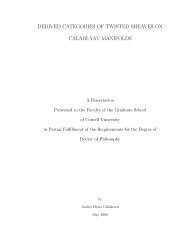Madden–Julian Oscillation analog and intraseasonal variability in a ...
Madden–Julian Oscillation analog and intraseasonal variability in a ...
Madden–Julian Oscillation analog and intraseasonal variability in a ...
You also want an ePaper? Increase the reach of your titles
YUMPU automatically turns print PDFs into web optimized ePapers that Google loves.
Table 1. Multicloud model parameter values<br />
Parameter Description Value<br />
conv Deep convective adjustment time 12 h<br />
s Stratiform heat<strong>in</strong>g adjustment time 7 days<br />
c Congestus heat<strong>in</strong>g adjustment time 7 days<br />
a0 Inverse buoyancy time scale of convective parameterization 12<br />
Q˜ Background moisture stratification 1.0<br />
eb em RCE value of the difference <strong>in</strong> equivalent potential temperature<br />
between the boundary layer <strong>and</strong> middle troposphere<br />
12 K<br />
˜ Second barocl<strong>in</strong>ic relative contribution to the moisture convergence<br />
associated with the background moisture gradient<br />
0.6<br />
u Momentum drag relaxation time 150 days<br />
Newtonian cool<strong>in</strong>g relaxation time 100 days<br />
Cd Boundary layer turbulent momentum friction coefficient 1.0 105 The values listed are used unless otherwise noted. Parameters not listed here take the same values as <strong>in</strong> the<br />
st<strong>and</strong>ard case of ref. 31.<br />
<strong>in</strong>stability of moist gravity waves. The multicloud model reproduces<br />
key features of the observational record for convectively<br />
coupled Kelv<strong>in</strong> waves or two-day waves (26, 35, 36), <strong>in</strong>clud<strong>in</strong>g<br />
phase speeds <strong>in</strong> the range of 15–20 ms 1 , vertical wave tilts, <strong>and</strong><br />
anomalous vertical dipoles <strong>in</strong> potential temperature.<br />
The Strategy for Produc<strong>in</strong>g an MJO Analog<br />
The strategy <strong>in</strong> this paper is to exploit the observed statistical<br />
self-similarity of tropical convection (37) <strong>and</strong> study the multicloud<br />
models for superclusters <strong>in</strong> a parameter regime appropriate<br />
for <strong><strong>in</strong>traseasonal</strong> <strong>variability</strong>.<br />
Key parameters of the multicloud model (31, 34) are the bulk<br />
climatological parameters: eb em, the mean equivalent<br />
potential temperature difference between the boundary layer<br />
<strong>and</strong> lower-middle troposphere; <strong>and</strong> Q˜ , the bulk low-level moisture<br />
gradient. Key parameters <strong>in</strong> the convective parameterization<br />
are the time scales for multicloud dynamics: congestus time<br />
scale c, deep convective time scale conv, <strong>and</strong> stratiform time<br />
scale s. In earlier work (31–34), the parameters c, conv, <strong>and</strong> s<br />
were used <strong>in</strong> the range of 1–3 h to parameterize the unresolved<br />
effects of convective wave packets from smaller scales on the<br />
equatorial synoptic supercluster scales. Here, by exploit<strong>in</strong>g the<br />
observed statistical self-similarity of tropical convection (37),<br />
the multicloud models are studied with the parameters c, conv,<br />
<strong>and</strong> s <strong>in</strong> an <strong><strong>in</strong>traseasonal</strong> planetary regime:<br />
conv O12 h, c, s O7 days. [1]<br />
Note that the time scale for conv <strong>in</strong> Eq. 1 is consistent with the<br />
current observational estimates for large-scale consumption of<br />
convective available potential energy (38). In addition, a current<br />
observational study of low-level moisten<strong>in</strong>g <strong>and</strong> congestus cloud<br />
development <strong>in</strong> the MJO suggests a time scale of 1–2 weeks for<br />
these processes, consistent with Eq. 1 (W. K.-M. Lau, personal<br />
communication). Of course, the long lags <strong>in</strong> Eq. 1 with forc<strong>in</strong>g<br />
<strong>and</strong> damp<strong>in</strong>g are surrogates for complex multiscale processes not<br />
resolved directly <strong>in</strong> the present model, which is why the term<strong>in</strong>ology<br />
‘‘MJO <strong>analog</strong>’’ is used throughout the paper.<br />
A realistic <strong>analog</strong> MJO wave should have all of the follow<strong>in</strong>g<br />
features:<br />
A. An actual propagation speed of 4–7 ms 1 predicted<br />
by theory.<br />
B. A wavenumber-2 or -3 structure for the low-frequency<br />
planetary-scale envelope with dist<strong>in</strong>ct active <strong>and</strong> <strong>in</strong>active<br />
phases of deep convection.<br />
C. An <strong>in</strong>termittent turbulent chaotic multiscale structure<br />
with<strong>in</strong> the wave envelope <strong>in</strong>volv<strong>in</strong>g embedded westward<strong>and</strong><br />
eastward-propagat<strong>in</strong>g deep convection events.<br />
D. Qualitative features of the low-frequency averaged<br />
planetary-scale envelope from the observational record<br />
<strong>in</strong> terms of, e.g., vertical structure of heat<strong>in</strong>g <strong>and</strong><br />
westerly w<strong>in</strong>d burst.<br />
[2]<br />
At the present time, only the MJO-like wave produced by<br />
Grabowski (17, 18) <strong>in</strong> numerical simulations has most of these<br />
features. In this paper, MJO <strong>analog</strong> waves with all four of the key<br />
features listed <strong>in</strong> Eq. 2 are produced <strong>and</strong> analyzed <strong>in</strong> the<br />
multicloud model <strong>in</strong> a suitable parameter regime with a constant<br />
sea surface temperature.<br />
The next step <strong>in</strong> the strategy is to vary the regime of climatological<br />
parameters eb em <strong>and</strong> Q˜ <strong>in</strong> l<strong>in</strong>ear stability analysis<br />
with all other parameters <strong>in</strong> the multicloud models fixed at their<br />
st<strong>and</strong>ard values as <strong>in</strong> refs. 31, 32, <strong>and</strong> 34. The key regime for the<br />
climatological parameters occurs when l<strong>in</strong>ear stability analysis<br />
predicts items A <strong>and</strong> B <strong>in</strong> Eq. 2, <strong>and</strong> simultaneously<br />
A l<strong>in</strong>early unstable b<strong>and</strong> at large scales with wavenumbers<br />
1 k O10 <strong>and</strong> growth rates of approximately<br />
(40 days) 1 to (20 days) 1 . [3]<br />
The plentiful b<strong>and</strong> of large-scale unstable wavenumbers is<br />
necessary to produce item C of Eq. 2 <strong>in</strong> the nonl<strong>in</strong>ear simulations<br />
as shown below. The robust regime of climatological parameters<br />
is explored below both through l<strong>in</strong>ear theory <strong>and</strong> nonl<strong>in</strong>ear<br />
simulations.<br />
It is worthwhile to mention here that the present models<br />
produce realistic MJO <strong>analog</strong> waves satisfy<strong>in</strong>g the conditions <strong>in</strong><br />
item C of Eq. 2 with<strong>in</strong> the multicloud model where the only<br />
nonl<strong>in</strong>ear mechanisms are<br />
A. Low-level moisture advection <strong>and</strong><br />
B. Nonl<strong>in</strong>ear switches for deep <strong>and</strong> congestus convection.<br />
[4]<br />
In particular, MJO <strong>analog</strong> waves satisfy<strong>in</strong>g item C of Eq. 2 are<br />
produced with<strong>in</strong> the multicloud model without the follow<strong>in</strong>g<br />
mechanisms: (i) w<strong>in</strong>d-<strong>in</strong>duced surface heat exchange (10, 11),<br />
(ii) boundary layer frictional moisture convergence, (iii) explicit<br />
effects of rotation through the beta effect, (iv) active radiation,<br />
(v) active atmosphere/ocean coupl<strong>in</strong>g, <strong>and</strong> (vi) upscale eddy flux<br />
9920 www.pnas.orgcgidoi10.1073pnas.0703572104 Majda et al.
















